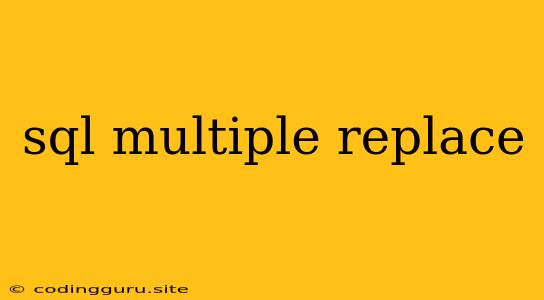SQL Multiple Replace: Simplifying Data Manipulation
In the world of data management, manipulating and transforming data is a common task. Often, you encounter situations where you need to replace multiple occurrences of specific values within a column. While SQL offers the REPLACE function for single replacements, how do you efficiently handle multiple replacements in a single query?
This article will explore various methods to achieve SQL multiple replace, empowering you to streamline your data transformation efforts.
Understanding the Challenge
Imagine you have a table storing product names with inconsistent formatting. Some entries might contain hyphens "-", while others use underscores "_". You need to replace both hyphens and underscores with spaces to standardize the data. A single REPLACE function won't suffice here.
Method 1: Chained REPLACE Functions
The most straightforward approach involves chaining multiple REPLACE functions. This method works by sequentially replacing each target value within the column.
Example:
UPDATE products
SET product_name = REPLACE(REPLACE(product_name, '-', ' '), '_', ' ');
This query first replaces all hyphens with spaces and then replaces all underscores with spaces, achieving the desired data transformation.
Advantages:
- Simple and easy to understand.
- Works well for a limited number of replacements.
Disadvantages:
- Can become cumbersome for a large number of replacements.
- Difficult to maintain and modify.
Method 2: CASE Statement
For more complex replacement scenarios, the CASE statement provides a flexible and powerful solution.
Example:
UPDATE products
SET product_name =
CASE
WHEN product_name LIKE '%-%' THEN REPLACE(product_name, '-', ' ')
WHEN product_name LIKE '%_%' THEN REPLACE(product_name, '_', ' ')
ELSE product_name
END;
This query uses CASE to check for the presence of hyphens or underscores and applies the corresponding replacement only when necessary. The ELSE clause ensures that other rows remain unchanged.
Advantages:
- Offers greater flexibility for complex scenarios.
- Allows for conditional replacements based on specific criteria.
Disadvantages:
- Requires careful planning and can become lengthy for numerous replacements.
Method 3: Regular Expressions (REGEX)
Regular expressions offer a concise and efficient way to perform multiple replacements using a single command. The REGEXP_REPLACE function (available in some database systems) allows you to specify a pattern for the replacement.
Example:
UPDATE products
SET product_name = REGEXP_REPLACE(product_name, '[-_]', ' ');
This query uses a regular expression [-_] to match both hyphens and underscores and replaces them with a space.
Advantages:
- Offers powerful pattern matching capabilities.
- Simplifies code for complex replacements.
Disadvantages:
- Requires understanding of regular expression syntax.
- May not be supported by all database systems.
Method 4: User-Defined Functions (UDF)
For scenarios demanding highly customizable and reusable solutions, user-defined functions (UDF) provide a powerful option. You can create a function that encapsulates your multiple replace logic, making it readily available for various queries.
Example:
CREATE FUNCTION replace_multiple(text VARCHAR(255), search_values TEXT, replace_value TEXT)
RETURNS TEXT
BEGIN
DECLARE i INT DEFAULT 1;
DECLARE result TEXT;
DECLARE value TEXT;
SET result = text;
WHILE i <= LENGTH(search_values) DO
SET value = SUBSTRING(search_values, i, 1);
SET result = REPLACE(result, value, replace_value);
SET i = i + 1;
END WHILE;
RETURN result;
END;
UPDATE products
SET product_name = replace_multiple(product_name, '-_', ' ');
This UDF takes the original text, a string of characters to search for, and the replacement value as input. It iterates through the search string, replacing each character with the specified replacement value.
Advantages:
- Offers highly customizable and reusable solutions.
- Improves code organization and maintainability.
Disadvantages:
- Requires advanced SQL knowledge.
- May introduce performance overhead depending on the database system.
**Choosing the Right Method for SQL Multiple Replace
The optimal method for SQL multiple replace depends on the complexity of your data transformation requirements.
- For simple replacements, chained
REPLACEfunctions are an efficient choice. - For conditional replacements,
CASEstatements offer flexibility. - For pattern-based replacements,
REGEXP_REPLACEprovides a concise solution. - For highly customizable and reusable solutions, consider user-defined functions.
Conclusion
Mastering SQL multiple replace techniques is essential for effective data manipulation. By understanding the different approaches and their advantages and disadvantages, you can choose the most appropriate method for your specific use case. This will enable you to efficiently transform your data, ensuring consistency, clarity, and accurate insights for your analysis and reporting needs.
